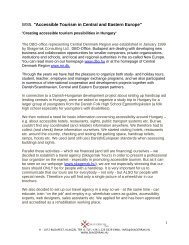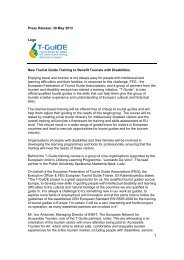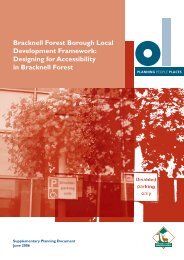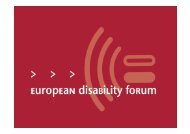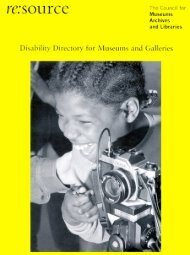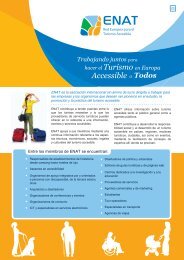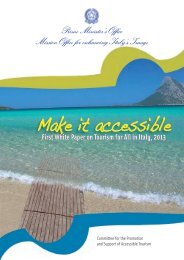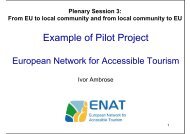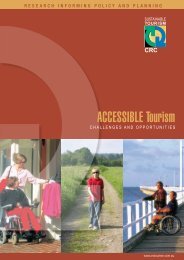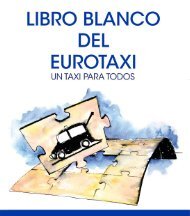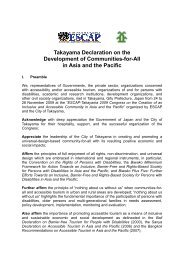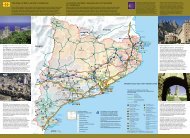Training needs analysis - EuForMe
Training needs analysis - EuForMe
Training needs analysis - EuForMe
You also want an ePaper? Increase the reach of your titles
YUMPU automatically turns print PDFs into web optimized ePapers that Google loves.
EU.FOR.ME Project<br />
Tourist training for a wider target<br />
<strong>Training</strong> <strong>needs</strong> <strong>analysis</strong>
Tourism for All Concept<br />
EVERYONE SHOULD BE ABLE TO TRAVEL TO THE<br />
COUNTRY, WITHIN THE COUNTRY AND TO WHATEVER<br />
PLACE, ATTRACTION OR EVENT THEY SHOULD WISH TO<br />
VISIT.<br />
2
1. TRAINING NEEDS ..............................................................................................................4<br />
1.1 METHODOLOGICAL PREMISE ..........................................................................................................4<br />
1.2 TRAINING NEEDS ANALYSIS IN PROJECT EU. FOR. ME.: GOALS, METHODOLOGIES AND<br />
INSTRUMENTS .........................................................................................................................................7<br />
1.3 THE CHARACTERISTICS OF THE TOURISM SECTOR.....................................................................11<br />
1. 4 THE TRAINING NEEDS EMERGING ..............................................................................................16<br />
1.5 GAPS IN THE TOURISM TRAINING OFFER...................................................................................27<br />
2. THE TRAINER SPECIALIZED IN TOPICS OF ACCESSIBLE<br />
TOURISM..........................................................................................................................................29<br />
2.1 CHARACTERISTICS OF THE PROFESSIONAL FIGURE ...................................................................29<br />
2.2 PROFESSIONAL PROFILE CHART...................................................................................................31<br />
3
1. TRAINING NEEDS<br />
1.1 Methodological premise<br />
In this section, in light also of the information reported in the previous chapters,<br />
the training <strong>needs</strong> emerging from the Project EU FOR ME investigation will be<br />
described. Before describing in detail the characteristics of the activity and the<br />
instruments used to identify the training <strong>needs</strong>, for a greater comprehension of<br />
the information reported below some synthetic indications about the function of<br />
the Needs Analysis must be supplied.<br />
Even though in the last decade Needs Analysis has assumed a key role in planning<br />
lines of intervention both in the training area and in the management of active<br />
labour policies, at the same time earning recognition as an essential element for<br />
socio-economic development, it is an “instrument” defined and structure to a<br />
limited extent.<br />
The training <strong>needs</strong> <strong>analysis</strong> revolves around complex and significant concepts such<br />
as training and training <strong>needs</strong>.<br />
In the training process 1 the <strong>needs</strong> <strong>analysis</strong> is configured as a “first activity” aimed<br />
at the acquisition of useful and credible data and information to continue in the<br />
planning of training experiences (definition of general and specific o0bjectives,<br />
identification of the targets, structuring of contents, choice of educational<br />
methods) and subsequently in the realisation of the training intervention itself 2 .<br />
It seems necessary to clarify the concept of “training need” which, albeit not<br />
having – at least not in the most recent literature on the subject - a unequivocal<br />
definition, is prevalently described as a gap, a lack to be filled, the distance<br />
1 Circular training process phases: <strong>needs</strong> <strong>analysis</strong> , planning interventions, planning activities,<br />
carrying out the training intervention, verification of results.<br />
2 G. Quaglino, P. Carrozzi, Il processo di formazione. Dall’analisi dei bisogni alla valutazione dei<br />
risultati (The training process. From <strong>needs</strong> <strong>analysis</strong> to the evaluation of the results), Franco Angeli,<br />
Milano, 2004<br />
4
etween the skills possessed by the subject and the skills necessary to effectively<br />
and efficiently carry out the activities within specific work processes.<br />
The training need, therefore, is closely related, both to the professional figure that<br />
the subject covers and to the set of skills required by the company (and/or, in the<br />
macro-dimension, by the industry) to carry out the work activities. The training<br />
need is, therefore, a describer of the status of relations between the individual and<br />
the organisation and as a consequence i san indicator of a “system of <strong>needs</strong>” that<br />
a specific company, or as in our case, a sector, manifests as a gap to be filled<br />
when faced with changes in the reference market or special requirements of the<br />
users of a service or product (for example tourists with specific <strong>needs</strong>,<br />
representatives of a market which is not yet understood and whose <strong>needs</strong> are not<br />
yet fully satisfied).<br />
As a consequence, the training need is configured as a potential area for the<br />
activation of training: knowledge of the training need allows the training planner<br />
to design a personalised and effective intervention.<br />
<strong>Training</strong> <strong>needs</strong> can be 3 :<br />
- explicit, expressed by the subjects representing the demand or the offer of<br />
the labour system;<br />
- evident, products of change in the labour market (change determined by<br />
regulatory innovations, product innovations, etc.), but not always expressed<br />
by the company/sector/territory;<br />
- latent, requirements from the business world but which have no response in<br />
the labour offer;<br />
- potential which can be found through a medium/long term <strong>analysis</strong> of the<br />
labour market.<br />
Another feature of the <strong>needs</strong> <strong>analysis</strong> is the dimension of the object observed. A<br />
need can, in fact, be defined:<br />
3 E. Catarsi, T. Cini, Progettare Formazione. Manuale per il progettista del sistema della formazione<br />
(Planning training: Manual for the training system planner), Edizione Cerro, Pisa, 2003<br />
5
- by a single subject, individual training <strong>needs</strong> from an empowerment<br />
viewpoint;<br />
- as part of a specific organisation/company, organisational <strong>analysis</strong> which<br />
must keep in mind the objectives, resources, internal and external climate,<br />
work processes, activities, roles;<br />
- with reference to the territory, <strong>analysis</strong> of the elements which describe<br />
certain capabilities and potentials for development in an area and as a<br />
consequence the training <strong>needs</strong> in the territory being examined;<br />
- as part of a specific production line/sector, <strong>analysis</strong> of the labour<br />
processes, of the activities, and professional figures which characterise a<br />
specific sector and represent elements necessary for identifying training<br />
<strong>needs</strong>.<br />
For a complete <strong>needs</strong> <strong>analysis</strong> that corresponds as closely as possible to reality,<br />
even if the object observed is changed certain principal areas of <strong>analysis</strong> remain<br />
constant, albeit assuming a different importance and weight; these include:<br />
- the companies,<br />
- the <strong>needs</strong> expressed by workers,<br />
- the new market orientations/requests,<br />
- the training offer of the sector investigated.<br />
As far as the procedures and instruments of the investigation are concerned, as<br />
emerges from the research conducted by the European Foundation for<br />
Management Development (1973- 1974), no shared reference “models” exist for<br />
<strong>needs</strong> <strong>analysis</strong>.<br />
It is commonly agreed that the phases of exploration and the instruments used<br />
must be specifically correlated to the objects observed and to the specific<br />
purposes of the <strong>analysis</strong>. This allows one to concentrate the investigative activities<br />
in order to gather information that is quantitatively and qualitatively useful in the<br />
definition of the training <strong>needs</strong>.<br />
6
The methodological outline, described synthetically, allows one to entirely<br />
comprehend the goals and the specific characteristics of the <strong>Training</strong> Needs<br />
Analysis activities of this project.<br />
1.2 <strong>Training</strong> Needs Analysis in Project EU. FOR. ME.: goals,<br />
methodologies and instruments<br />
For Project EU FOR ME – Tourism <strong>Training</strong> for a Wider Target, the Needs Analysis<br />
served in planning a training action destined for Trainers specialised in the<br />
topics of “tourism for all”.<br />
The “context”, within which the general and specific objectives of the entire joint<br />
action are pursued, has been the object of observation for the definition of the<br />
Needs Analysis.<br />
The information gathered through the training <strong>needs</strong> <strong>analysis</strong> , therefore, will be<br />
necessary elements in planning a training path for trainers who will have to<br />
conduct activities to fill the skill gaps present in the sector being examined and at<br />
the same time have allowed us to draw a picture of the whole which has allowed<br />
the research team to understand the “state of the art” of “tourism for all” and<br />
detect indicators of knowledge about and awareness of this topic.<br />
The way of conducting the training <strong>needs</strong> <strong>analysis</strong> and the related instruments<br />
have been designed and realised keeping in mind three important aspects of the<br />
object under observation, and those are:<br />
- the <strong>needs</strong> of tourists with special <strong>needs</strong>;<br />
- the tourism supply system;<br />
- the training offer for the tourism industry<br />
<strong>Training</strong> <strong>needs</strong> could not, in fact, be identified by gathering information exclusively<br />
regarding the skill gaps of sector operators because:<br />
‣ as mentioned in the methodological premise, training <strong>needs</strong> <strong>analysis</strong><br />
activity cannot leave out of consideration a “focus” on new market orientations.<br />
7
In this case the tourism demand determines strong changes and specifically the<br />
requirements of tourists with special <strong>needs</strong> supply essential indications of the<br />
characteristics of a training intervention dedicated to a figure which must help<br />
tourism operators to acquire the skills indispensable to offer a “tourism for all<br />
product”;<br />
‣ the training path to be planned foresees as its direct targets not the<br />
operators but subjects able to train tourism operators in the topics of<br />
accessibility. As a consequence the field of research was not limited to specific<br />
professional figures of the tourism production line, the object of the investigation<br />
was the skills lacking in the various professional figures operating in the various<br />
types of tourism companies;<br />
‣ to be effective, the training activity in question must “position itself” in<br />
the panorama of training offer responding to gaps in tourism training, such an<br />
<strong>analysis</strong> is also necessary to reach one of the goals of the project: to develop<br />
and test training modules on the topics of the accessibility of the tourism<br />
product, of welcoming the disabled client and of the preparation of products<br />
suited to the target identified.<br />
In correspondence to the three “aspects” we have identified:<br />
as fare as the requirements of tourists with special <strong>needs</strong> are concerned:<br />
specific <strong>needs</strong> in the various phases of travel and skills ought in tourism<br />
operators;<br />
in the area of the tourism supply system: the main structural and<br />
organisational features of businesses that operate in the are of “tourism for<br />
all”, the main reasons for “resistance” of businesses that do not offer<br />
“tourism for all”, and, especially, professional training <strong>needs</strong> to offer a<br />
quality product/ service (in terms of skills to strengthen, requests for<br />
specific professional figures, opinions on the training activity offer);<br />
regarding the training offer: the gaps in the current tourism training<br />
programmes on topics related to accessible tourism.<br />
8
To gather the information listed above, the following survey instruments were fine<br />
tuned:<br />
- Focus Group of young persons with disabilities and the related<br />
Guidelines/grid for conducting the debate;<br />
- Focus Group with sector operators and the related Guidelines/grid for its<br />
realisation. Wherever it was impossible to organise a Focus Group, the<br />
research groups conducted interviews with a grid of questions following the<br />
fields indicated in the guidelines for the focus groups;<br />
- Census and <strong>analysis</strong> of the training offer and related guidelines for<br />
conducting this.<br />
The instruments indicated above have been described in previous documents,<br />
nevertheless it would be opportune in this context to provide motivations for the<br />
choice.<br />
The Focus Group, qualitative social research technique – understood as an<br />
interview of a homogeneous group of persons – allowed us, through guided<br />
debate, to gather information on a specific topic avoiding the factors of<br />
“conditioning” that can interfere in other research techniques, such as, for<br />
example, in structured or semi-structured interviews.<br />
The Focus Group method was fully applied for the survey that involved the young<br />
disabled persons.<br />
The Focus Groups among operators held in the countries of the project partners,<br />
because of concurrence with Tourism Fairs and the work commitments of the<br />
operators, in some cases took place through individual telephone interviews.<br />
This difficulty in organising research and study meetings among operators was<br />
also encountered in other research projects. In fact the persons who manage<br />
tourism businesses, generally family-run or small/medium sized businesses, are<br />
busy for the greater part of the day and have difficulty delegating their activities.<br />
In this action the research teams who could not involve the tourism operators in a<br />
Focus Group prepared a grid of interviews with items corresponding to the<br />
questions indicated in the Focus Group guidelines. The number of operators who<br />
9
esponded to these interviews corresponded to the number of participants<br />
established for the focus groups.<br />
In the Focus groups, through the roles of the moderators and observers, it was<br />
possible to investigate the topic in depth through a debate which, especially at the<br />
moment of the concluding reflections, allowed us to identify the strengths and<br />
weaknesses of the real and the potential “tourism for all” both on the part of the<br />
demand and the offer.<br />
The instrument of the interview allowed us to gather prevalently quantitative data.<br />
The characteristics of the persons involved were a strength of the investigation<br />
instrument, in fact each partner managed to involve subjects who broadly<br />
represented the reality studied. The participants were determined according to the<br />
characteristics, shared and indicated in the support grid, believed to be important<br />
in relation to the topic discussed and the topics of the research.<br />
In the case of the Focus Group dedicated to the <strong>analysis</strong> of the <strong>needs</strong> of tourists<br />
with disabilities a significant representation of the specific <strong>needs</strong> was reached,<br />
moreover their “companions” were also involved. Regarding the investigation of<br />
the operators, in most cases all types of tourism firms were represented (hotel<br />
and non-hotel hospitality, food service, transportation and travel intermediation,<br />
Tourist Information and Welcoming Offices) and the category associations were<br />
also involved in the debate.<br />
The instruments of the investigation used allowed us to go in depth into specific<br />
topics in a relatively brief period of time, dictated by the programming of the<br />
planning activity, and to gather information that could be easily understood and<br />
processed by the researchers.<br />
As far as the <strong>analysis</strong> of the current training programmes on the topic of<br />
accessible tourism are concerned, a “census” was made of the training products<br />
following a specially formulated grid of listings and <strong>analysis</strong>, even in relation to the<br />
time available and to the need to share the methodology among the partners.<br />
The various forms of training offer were the object of the <strong>analysis</strong>, specifically:<br />
10
- University courses;<br />
- Higher training activity / post-graduate Masters;<br />
- <strong>Training</strong> interventions financed by the Public Administration and/or by the<br />
ESF conducted in 2004 or underway.<br />
The research team has identified and described, in the support document to the<br />
research, the purposes, research methodologies and reporting method (for the<br />
description of the above mentioned elements see the document: “Study of training<br />
systems”).<br />
At the end of this activity each partner drew up a research report containing,<br />
besides a list of the products existing and of the subjects and/or topics regarding<br />
tourism for all, also a quantitative (based on shared indicators) and qualitative<br />
<strong>analysis</strong>.<br />
The research teams found the information by consulting sources such as<br />
educational programmes (found at the Internet sites of the Universities or at their<br />
educational secretariats), data bases, training programmes (through the<br />
competent public administrations), programmes drawn up by individual lecturers<br />
(directly contacting the professor responsible for the chair).<br />
The quantitative- qualitative information, systematized by each partner in the<br />
interim reports after various research “moments”, were compared and are<br />
container in the synthetic document.<br />
1.3 The characteristics of the tourism sector<br />
In order to permit an integrated interpretation between the training <strong>needs</strong><br />
emerging from the research and the professional figures vectors of these <strong>needs</strong><br />
we must propose a synthetic description of the tourism system, specifically of the<br />
types of businesses composing the production line itself with focus on the<br />
characteristics of the product and consequently of the professional figures.<br />
The description presented below does not pretend to be exhaustive, rather the<br />
intention is to offer some elements of interpretation to relate the skill gap found<br />
11
with the various types of firms in the production line and as a consequence with<br />
the production processes and the professional figures.<br />
The tourism system is composed of: a public sector (in turn composed of<br />
“support services” such as, for example, local agencies, public tourism<br />
organisations, etc); a private sector (understood as companies that offer support<br />
services: for example specialised press, private schools, etc); the producers of a<br />
service/product. With this last definition we intend the different types of<br />
businesses in the production line, specifically:<br />
- vectors (that is, transportation operators: air, sea, rail, road);<br />
- hospitality businesses (both hotel and non-hotel hospitality businesses)<br />
- food service businesses (which includes operators of collective and<br />
commercial food services).<br />
The so-called distributors, that is the channel through which a product or service<br />
is distributed from its production sources to the potential consumer, also ate a<br />
part of the tourism system. Among the traditional distributors we cite the tour<br />
operators, travel agencies, incoming travel agencies; among the new channels we<br />
have instead the web, digital TV, etc. 4 .<br />
An important element of the tourism system is represented by the<br />
“consumers/clients” who strongly influence production, since to date they are<br />
characterised by a marked capacity for critical choice of the offer strongly<br />
connected to the characteristics of the tourism product/service.<br />
The tourism service is highly complex: it is abstract, intangible, and for the<br />
intangibility itself of the product the image becomes a characteristic of quality.<br />
Instrumental goods are certainly a necessary condition for the production of<br />
tourism services, but it is the way in which the relationship between persons is<br />
approached and managed that qualifies and gives content, even economic, to the<br />
production and sales of the services.<br />
4 O. N. Fiorucci, Il sistema turistico,educational material produced for the training course “Manager<br />
dei processi formativi” Assisi, 2005<br />
12
Also the tourism product is consumed immediately, in fact often the production<br />
process is carried out at the same moment as consumption.<br />
As a consequence professionalism in the tourism sector is characterised essentially<br />
by the “presence” and by the “physicalness” of its operators; the moment of<br />
contact between the operator and the client strongly influences the quality of the<br />
product.<br />
Professionalism, therefore, is understood as the fundamental attitude of maximum<br />
perception and helpfulness towards the persons/clients.<br />
The consumer attributes great importance to the product/service and often<br />
identifies it with the persons who create and represent it. As a consequence the<br />
professionalism of human resources, as a central element for the definition of the<br />
quality level of the production, cannot be limited to mere possession of technicalprofessional<br />
skills, but must be integrated with the ability to perceive <strong>needs</strong> and<br />
the necessities of the users 5 .<br />
To clarify what has been written above, by “skill” we mean Knowledge, knowing<br />
how to be, and knowing how to do. Skills are further distinguished, in the<br />
literature on the subject, into:<br />
- basic skills, considered fundamental requirements to guarantee the<br />
employability of the person (to have access to the work force) and personal<br />
development. These are independent of the concrete operational processes in<br />
which the worker is involved in carrying out his or her job. Therefore these are<br />
skills common to all the professions, commonly recognised as new "rights of<br />
citizenship" in the labour market and in society. These basic skills are fundamental<br />
to face change;<br />
- transversal skills, include the characteristics and the individual processes that<br />
come into play when a person reacts to a request from the work environment but<br />
these are not connected to a specific work activity;<br />
5 S. Poeta , L’analisi dei fabbisogni formativi e professionali del settore turismo, Franco Angeli,<br />
Milano, 2000<br />
13
- technical – professional skills, directly connected to the conduction of<br />
professional activities or in any event connected to certain work processes<br />
(operational and technical know how).<br />
Given the characteristics of the tourism product cited above, the professions of the<br />
production line are marked by the possession of evident transversal skills such as,<br />
for example, communications techniques, knowing how to work in a group,<br />
problem solving, etc.<br />
The professional figures in the tourism industry can be divided principally into:<br />
- persons in charge of the production of goods and services not in direct contact<br />
with the clientele (back house)<br />
- persons concerned with the distribution of goods and services in continuous<br />
direct contact with the clientele (front house).<br />
This distinction represents an abstraction used mainly for the <strong>analysis</strong> of the<br />
professions themselves, in fact among the characteristics that can be found in<br />
such professions we point out that:<br />
- there is a strong de-specialisation of roles: the activities carried out by<br />
workers are often outside those foreseen by the role covered. The<br />
motivation of this phenomenon can be found in the average size of the<br />
businesses that make up the production line.<br />
- There is a strong seasonality<br />
- There is marked turn over<br />
- The ability to work in a group is marked yet at the same time autonomy in<br />
managing one’s role is required 6 .<br />
The production process in which the professional figures are positioned is<br />
represented by a cycle composed of seven phases:<br />
‣ Start up, construction of the product<br />
‣ Approach, first direct or in direct contact with the clients<br />
‣ arrival, action to facilitate consumption of the product<br />
6 Stefano Poeta, L’analisi dei fabbisogni formativi e professionali del settore turismo, Franco Angeli,<br />
2000<br />
14
‣ welcoming, first contact<br />
‣ purchase, direct contact<br />
‣ consumption, enjoyment of the product/service<br />
‣ departure /feedback, leave-taking of the client and fidelity actions.<br />
The complexity of the tourism sector and consequently of the universe of the<br />
professions can certainly not be represented here. The importance that the sector<br />
assumes not only in the economy of a nation but also in the socio-cultural context<br />
is evident; this last aspect determines the need for a product/service responding<br />
to the <strong>needs</strong> of the client and guaranteeing an elevated quality.<br />
Faced with an increasingly complex and competitive market, in a realty in which<br />
consumer-tourists request new and personalised tourism products, tourism<br />
businesses must provide the cultural, organisational and managerial innovation to<br />
support a suitable offer.<br />
Amongst the emerging demand it is possible to find that of persons with special<br />
<strong>needs</strong> which, to date, have not found an adequate offer in response..<br />
The testimony of persons with special <strong>needs</strong> has confirmed, in fact, what has<br />
emerged from recent research. Among the central points:<br />
- the tourist with a disability is not considered and therefore, treated like a<br />
normal client;<br />
- often tourism operators do nothing to make a vacation possible, it is the<br />
tourist who must find the solutions;<br />
- little attention is paid to the free time of tourists with disabilities.<br />
15
1. 4 The training <strong>needs</strong> emerging<br />
In this paragraph we intend to present and comment on the emerging training<br />
<strong>needs</strong>.<br />
These have been identified by the research team through the realisation of the<br />
following steps:<br />
a) <strong>analysis</strong> of the reports drawn up by each partner;<br />
b) study of the syntheses (specifically: “An <strong>analysis</strong> of the <strong>needs</strong> expressed by the<br />
target of tourists with disabilities”, “Study of training system”);<br />
c) comparison and identification of the correlations, if present, between the <strong>needs</strong><br />
indicated by disabled tourists and the problems manifested by the operators;<br />
d) identification of the skills lacking for each need and perception found.<br />
This step was necessary because the subjects involved in the survey expressed<br />
their perceptions, not only in the form of skills expected or sought in tourism<br />
operators, but rather in terms of:<br />
- critical aspect, in the organisation and carrying out of the tour as far as the<br />
disabled tourist is concerned, and in the construction and sale of an<br />
accessible tourism product as far as the operators are concerned,<br />
- requirement of tourists with special <strong>needs</strong><br />
- elements that make a structure or a place accessible<br />
- structural interventions and interventions in the business organisation<br />
necessary to offer an accessible tourism product.<br />
We remind you that the gaps in skills (skills lacking), defined in the<br />
methodological premise of this report, represent in our case indicators of a<br />
“system of <strong>needs</strong>” manifested by the tourism offer in order to set going work<br />
processes and activities which allow the supply of an accessible tourism product.<br />
e) definition, corresponding to the skills lacking that were found in the step<br />
described in point d), of the corresponding training <strong>needs</strong>, in this phase the<br />
potential areas in which to set up training to fill the gaps were identified;<br />
16
f) verification of the existence, in the panorama of the training offer in the are of<br />
“tourism for all”, of interventions aimed at satisfying the <strong>needs</strong> which emerged<br />
(the results of this activity will be summarised in paragraph 1.5).<br />
We held it to be opportune to summarise results of the <strong>analysis</strong> described above<br />
by formulating the table printed below which, through a horizontal reading, allows<br />
the reader to gather the correlations found and, as a consequence, the logical path<br />
that led to the definition of the training <strong>needs</strong>.<br />
It is clear, also in light of what has been said in the methodological premise, that<br />
to the <strong>needs</strong> of the disabled and to the impressions of the operators more than<br />
one lacking skill will correspond, because the satisfaction of <strong>needs</strong> and the<br />
overcoming of difficulties require that various work activities be set in motion, as a<br />
consequence the training <strong>needs</strong> indicated in the individual cells in the last column<br />
of the table are heterogeneous.<br />
Therefore training intervention has been designed by constructing training units<br />
that respond to training <strong>needs</strong> referring to the same areas of activity.<br />
Within the structured table the contents of some cells related to the impressions of<br />
the operators are empty because they did not point out any problems or elements<br />
similar to the <strong>needs</strong> of the disabled.<br />
The lack on the part of the operators of these elements in response to the specific<br />
<strong>needs</strong> emerging was interpreted as:<br />
- a unawareness of the need;<br />
- insensibility to the specific problem;<br />
- conviction of having already satisfied the specific need<br />
With relation to these elements it was in any event held to be opportune to<br />
indicate the training <strong>needs</strong>. The descriptive table can be found below, followed by<br />
an overall comment.<br />
17
Needs of the disabled<br />
Impression of the<br />
Skills lacking<br />
<strong>Training</strong> need<br />
operators<br />
Operators are unable to<br />
Lack of knowledge of the<br />
Communications skills<br />
Communications techniques<br />
give reliable information<br />
<strong>needs</strong> of tourists with<br />
Problem solving skills<br />
Problem identification and<br />
and to reply in a pertinent<br />
special <strong>needs</strong> and of the<br />
Knowledge of disabilities<br />
solving techniques<br />
way to specific questions<br />
types of disabilities<br />
Knowledge of the product<br />
Disabilities and specific<br />
offered<br />
<strong>needs</strong><br />
Accessibility<br />
of<br />
products/services offered<br />
Instruments and methods<br />
for evaluating accessibility<br />
Website difficult to access<br />
Difficulty of the persons<br />
Ability to promote &<br />
Techniques for the selection<br />
and with out-of-date<br />
assigned to give<br />
communicate<br />
the<br />
and management of<br />
information<br />
information about the<br />
product/service<br />
offered<br />
information<br />
territory in gathering<br />
even through Internet sites<br />
Web marketing techniques<br />
18
information and keeping it<br />
up-to-date<br />
and other channels<br />
Techniques for constructing<br />
accessible web sites<br />
19
Needs of the disabled<br />
Impression of the<br />
Skills lacking<br />
<strong>Training</strong> need<br />
operators<br />
Need for reliable<br />
Difficulty in proposing an<br />
Technical-professional skills<br />
Information sources and<br />
information about the<br />
integrated<br />
accessible<br />
inherent to the construction<br />
the services available for<br />
accessibility of a territory,<br />
product<br />
of accessible packages<br />
the construction of an<br />
of means of transportation,<br />
The territory where the<br />
Knowledge of the reference<br />
accessible tourism product<br />
of collateral sectors (free<br />
structure is located is not<br />
territory<br />
Marketing techniques for<br />
time, nature trails, etc)<br />
accessible<br />
Skills necessary for the<br />
the promotion of an<br />
creation of a collaboration<br />
accessible product and<br />
between<br />
operators’<br />
territory<br />
associations and the<br />
Techniques for the<br />
associations<br />
representing<br />
construction<br />
and<br />
persons with specific <strong>needs</strong><br />
management of relations<br />
and collaborations with<br />
public and private actors of<br />
20
the territory for the<br />
construction of an<br />
integrated tourism product<br />
Inaccessibility<br />
of<br />
Lack of knowledge about<br />
Awareness of the concept<br />
Fundamental aspects of<br />
structures, open spaces,<br />
the requirements for<br />
of accessibility<br />
accessible tourism<br />
sanitary services and a lack<br />
making<br />
structures<br />
Knowledge of and the<br />
Legislative framework<br />
of adequate signage<br />
accessible<br />
ability to abide by the<br />
Accessibility<br />
evaluation<br />
Lack of knowledge of the<br />
regulations on the subject<br />
criteria<br />
reference regulations<br />
Lack of communications<br />
Knowledge of the<br />
The principal means of<br />
devices suitable for the<br />
instruments for making<br />
alternative communications<br />
hearing-impaired<br />
communications accessible<br />
21
Needs of the disabled<br />
Little care in handling and<br />
look after the aids<br />
transported<br />
Lack of equipment and<br />
specific aids (for example<br />
on beaches)<br />
Lack of indications/safety<br />
devices in case of<br />
emergencies<br />
Impression of the<br />
operators<br />
Skills lacking<br />
<strong>Training</strong> need<br />
Knowledge of aids<br />
Aids and their safekeeping<br />
Skill in problem solving and Communications techniques<br />
relationships<br />
Knowledge of special <strong>needs</strong> Disabilities and special<br />
<strong>needs</strong><br />
Principles of safety in the Safety in the workplace<br />
workplace and fire Connection between the<br />
prevention regulations regulations on the<br />
Risk communication elimination of architectural<br />
techniques<br />
barriers and fire-prevention<br />
regulations<br />
22
Needs of the disabled<br />
Inability to involve disabled<br />
persons on the part of<br />
recreation operators<br />
Management of guided<br />
visits so that the disabled<br />
can participate<br />
Relationship skills<br />
Impression of the<br />
Skills lacking<br />
operators<br />
Embarrassment in relations Communications and<br />
with tourists with special interpersonal relations<br />
<strong>needs</strong><br />
techniques<br />
Knowledge of specific <strong>needs</strong><br />
Lack of tour guides able to Construction of accessible<br />
propose itineraries and paths and destinations<br />
guided visits accessible to<br />
all<br />
Knowledge of sign language<br />
Difficulty in relating to a Skills for welcoming and<br />
clientele with special <strong>needs</strong> handling clients<br />
Relationship skills<br />
23<br />
<strong>Training</strong> need<br />
Techniques for welcoming<br />
and entertaining clients<br />
with special <strong>needs</strong><br />
Special <strong>needs</strong><br />
The territory<br />
Communications and<br />
relationship techniques<br />
Principles of sign language<br />
Techniques for welcoming<br />
and handling clients with<br />
special <strong>needs</strong><br />
Communications and<br />
interpersonal relationship<br />
techniques
Need to integrate the offer<br />
Difficulty in selling a service<br />
Education in accessibility<br />
Raising the awareness of<br />
aimed at tourists with<br />
to destinations “addressed”<br />
tourists<br />
special <strong>needs</strong> with that<br />
to all clients<br />
existing in normal circuits<br />
24
As can easily be understood from reading of the information in the table, there are<br />
still many gaps in the skills indispensable to produce and sell a “tourism for all”<br />
product.<br />
The tourism operators involved in the research, pointed out how in the sector<br />
there is not yet a full awareness of the market segment represented by tourists<br />
with special <strong>needs</strong>, great part of the tourism offer does not consider accessible<br />
tourism to be an opportunity for economic growth.<br />
The research partners appear to share a need for activities to raise awareness<br />
about this topic, actions understood above all as moments of dissemination of<br />
knowledge and skills that are unavoidable for the creation of accessible tourism.<br />
The skills lacking are for the most part transversal to the various types of tourism<br />
business, further characterised according to the work processes of the business.<br />
For example the need of the disabled to have precise and reliable information and<br />
the related lack of knowledge about special <strong>needs</strong> shown by the operators<br />
regards:<br />
- hospitality businesses: information about the accessibility of the structure<br />
and the reference territory<br />
- food service businesses: information about the accessibility of the structure<br />
and the composition of food (to respond, for example, to subjects with<br />
particular nutritional <strong>needs</strong>)<br />
- vectors: accessibility of means of communications (transportation), ways of<br />
use, etc.<br />
- travel intermediation businesses: in-depth information on the components of<br />
the tourism packages proposed.<br />
Following the <strong>needs</strong> of the disabled emerging during the focus groups/interviews –<br />
which highlighted the importance of relations with the operators - the moderators<br />
tried to understand what weight the operators themselves attribute to the skills of<br />
the human resources of the structure.<br />
It emerged that, although on the part of the tourism operators the accessible<br />
tourism product is identified prevalently with the accessibility of the structure and
the skills regarding “tourism for all” are not among the prerequisites sought in the<br />
phase of hiring personnel, the operators perceive the importance of the<br />
relationship between operator and tourist/client, therefore they recognise the lack<br />
of various skills necessary for handling relations with clients with special <strong>needs</strong>.<br />
Therefore the “human factor” assumes an important role especially where the<br />
operator cannot guarantee the inexistence of barriers or elements of<br />
inaccessibility. In this case the ability of the worker to identify and resolve the<br />
problem is fundamental, especially through communications and exchange with<br />
the client, but this must necessarily be backed up by an elementary skill in the are<br />
of disabilities and special <strong>needs</strong>.<br />
It can be deduced that the skills identified and detailed in the table undoubtedly<br />
assume value and specific characteristic seven in virtue of the professional figure.<br />
The human resources assigned to front office roles (in direct contact with the<br />
clientele) are more aware of the communications and relationship skills gap.<br />
Nevertheless, it is generally agreed that a tourism product can really be<br />
considered accessible only if the entire organisational structure knows and works<br />
to respond to the special <strong>needs</strong> of tourists.<br />
To summarise, the training <strong>needs</strong> identified regard both the so-called transversal<br />
skills (interpersonal communications, problem solving techniques,) and the<br />
technical-professional skills (techniques for constructing accessible products -<br />
packages/itineraries/stays, techniques for the promotion and commercialisation of<br />
accessible products/services, knowledge of sign language, knowledge of the<br />
elements for making a structure accessible, etc.), and the basic skills such as, for<br />
example, safety in the workplace also in relation to the disabled client.<br />
Without doubt it is essential, in order to develop the skills indicated above, that<br />
awareness the concepts of “accessibility” and “tourism for all” which are fully<br />
understood neither by the business operators nor by the territorial realities, be<br />
raised and that the concepts themselves be more clearly defined.. In fact, from an<br />
<strong>analysis</strong> of the <strong>needs</strong> it emerges that information and training interventions aimed<br />
at responding to the above-mentioned <strong>needs</strong> should have as their target users not<br />
26
only operators of tourism businesses but also the public actors who offer “support<br />
services“ to the tourism sector and who must necessarily enter into the philosophy<br />
of an accessible territory. In fact, a tourism product is not merely the service<br />
offered by a restaurant or by a hospitality structure but it is of necessity the set of<br />
attractions and resources that the reference geographical area offers.<br />
“Tourism for all” presumes, therefore, a strong client orientation rather than<br />
product orientation. In this light the centrality of the consumer and his/her <strong>needs</strong><br />
is recognised and as a consequence all those actions (enter into relations with the<br />
client, identify his/her <strong>needs</strong>, adapt the production processes and the product to<br />
the <strong>needs</strong> expressed) must be activated which allow businesses to offer a product<br />
responding to the various <strong>needs</strong>.<br />
In order to set in motion a client oriented policy the business must receive the<br />
client’s requests (or those of a target of clients) as spurs to learning and must be<br />
willing to learn continuously. This necessary condition determines the central role<br />
of the continuous training of operators.<br />
1.5 Gaps in the tourism training offer<br />
In line with what has been said above, the investigation of the <strong>needs</strong>, after<br />
identifying the skills gaps, calls for an <strong>analysis</strong> of the tourism training offer<br />
currently available in the area of “tourism for all”.<br />
The types of training offer analysed are:<br />
- university courses<br />
- advanced training /post-graduate master’s programmes<br />
- training activity financed by P.A. and by the ESF conducted in 2004 or<br />
underway.<br />
From a comparison of the information reported by each partner it clearly emerges<br />
that the topic “tourism for all” is not dealt with in the training paths except for in<br />
isolated cases. This gap regards both the educational programmes of university<br />
27
courses and those related to post-graduate master’s studies. “Tourism for all”,<br />
therefore, is neither a subject in itself nor a topic included in other teachings. This<br />
lack is even more serious in reference to post-graduate specialisation courses, in<br />
which the basic subjects are considered to have been already learned by the<br />
students and only qualifying subjects are considered.<br />
The topics of “tourism for all”, such as, for example, the accessibility of structures,<br />
an <strong>analysis</strong> of specific <strong>needs</strong>, techniques for relating to disable tourists, etc, are,<br />
therefore, absent from the educational programmes in the university offer or even<br />
that of truly rich and complete post-graduate tourism courses.<br />
As far as the training courses financed in 2004 are concerned and among the<br />
activities still in course, the research has shown the limited presence of<br />
educational modules or topics inherent to “tourism for all”.<br />
Therefore the <strong>needs</strong> <strong>analysis</strong> has confirmed the hypothesis formulated in the<br />
planning stage, that is that the tourism training offer:<br />
- is not prepared to train students and professionals in the topics of a broader<br />
tourism;<br />
- in nearly all cases training activity aimed at understanding and technically<br />
evaluating the <strong>needs</strong> of the disabled is not foreseen;<br />
- does not prepare students to welcome this target of clientele.<br />
In light of the evident request for “tourism for all” and of the results of the training<br />
<strong>needs</strong> <strong>analysis</strong>, in order to fill the skills gap of the operators and the evident<br />
inadequacy of the training offer o the subject a professional figure has been<br />
identified, the Trainer specialised in topics of accessible tourism, who should<br />
facilitate the activities of information and training with operators and be able to<br />
propose training integrations for educational programmes. For this figure a<br />
training path has been proposed with a view to a response to the main <strong>needs</strong><br />
emerging.<br />
In the next chapter the possible effects in tourism businesses of the work of the<br />
Trainer specialised in topics of accessible tourism will be illustrated, together with<br />
the professional profile and the areas of “spendability”.<br />
28
2. THE TRAINER SPECIALIZED IN TOPICS OF ACCESSIBLE<br />
TOURISM<br />
2.1 Characteristics of the professional figure<br />
For the tourism offer to place its attention on the demand means in the first place<br />
that it must consider tourists as persons, distinct identities who seek a humanised<br />
relationship with the business and the operator. 7 .<br />
This determines an awareness that it is the tourists/clients who make the choice<br />
and that their interests will be directed prevalently toward offers that are coherent<br />
with their expectations.<br />
In this light the training activities aimed at operators of the sector should develop<br />
a culture of the user thanks to which the technical-professional skills, put into act<br />
for specific work processes and activities, do not support simple standardised<br />
procedures but rather permit the operator to manage a tourism demand that is<br />
increasingly heterogeneous and able to choose.<br />
With a view to increasing the operator’s client orientation, the training actions<br />
aimed at raising the awareness and training on the topic of “tourism for all” must<br />
first of all respond to the specific training <strong>needs</strong> brought forward by this research<br />
and consequently propose new skills. Continuous training activities (that is, aimed<br />
at workers), while an important lever to enhance businesses and make them<br />
competitive, in the tourism sector do not receive proper attention from<br />
entrepreneurs/operators. This can be attributed to:<br />
- lack of time to dedicate to training (especially for family-run businesses or<br />
small-medium sized businesses),<br />
- the presence of self-made men, that is operators who learned their skills on<br />
the job and have a low educational level;<br />
- diffidence on the part of the operators toward “academic” training;<br />
7 G. Calvi, Non più consumatori: solo clienti. Una sfida per il mercato (No more consumers, just<br />
clients. A challenge for the market), in Socialtrends n. 56, April 1992.<br />
29
- the propensity to invest in activities that give immediate results, while<br />
training produces long-term advantages.<br />
As far as university and advanced training is concerned, the research has brought<br />
to light the presence of training interventions prevalently centred on acquiring<br />
knowledge rather than skills (to know, to know how to do and to know how to be)<br />
and a lack of activities aimed at acquiring specific skills especially on “tourism for<br />
all”.<br />
To fill the gap between the <strong>needs</strong> of the operators, present and future, and the<br />
training offer it will be necessari to plan and and carry out training interventions<br />
for operators and propose training units to insert into the educational programmes<br />
of degree courses, masters and financed activities of advanced training.<br />
To realise all of this, Project EU FOR ME calls for training activity aimed at<br />
preparing a professional figures to facilitate such interventions through the testing<br />
of training modules, designed by them, on the topics of the accessibility of the<br />
tourism product, of welcoming the disabled client and of the preparation of<br />
products suited to the target identified.<br />
By comparing the information emerging from the <strong>needs</strong> <strong>analysis</strong>, of the current<br />
situation of “tourism for all”, of the relationship between training and the tourism<br />
production line, the skills that the Trainer specialised in the topics of accessible<br />
tourism must possess have been identified.<br />
Considering training as a decisive factor for the development of human resources<br />
and therefore of the business, the main characteristics that must be present in a<br />
training intervention on the topic of “tourism for all” have been identified:<br />
- non-passive teaching methods, centred rather on the experiential aspects<br />
and the use of active methods (ex. simulations)<br />
- contained timing centred on specific themes<br />
- clear training language.<br />
Given the characteristics listed above, the trainer is a consultant in support of<br />
learning oriented not only toward the individual but also to the organisation<br />
learning not limited to a single intervention, but continuous over time.<br />
30
Therefore the tasks of the professional figure identified will be:<br />
- see to it that training becomes an element integrated with the management<br />
of the organisation and of personnel;<br />
- propose training activities that respond to the specific <strong>needs</strong> about “tourism<br />
for all” of the company/operators (differentiated according to the type of<br />
business);<br />
- create learning environments using the workplace, the students’ experience,<br />
the presentation of good practices, the use of training methodologies (selflearning,<br />
At-a-distance learning, etc)<br />
- support the operators in complete knowledge of “tourism for all”<br />
- evaluate the results of training and flank the workers in on the job<br />
experience.<br />
Moreover, as called for in the project, students who attend the training course for<br />
Trainer specialised in the topics of accessible tourism will plan, through project<br />
work, modules on the topics of “tourism for all” which they will test themselves<br />
during training courses, professional laboratories and degree courses.<br />
Below you will find a synthetic outline of the professional profile.<br />
2.2 Professional profile chart<br />
1. Name<br />
Trainer specialised in the topics of accessible tourism<br />
2.Description<br />
This is a technical specialist figure which works in the field of planning, promoting<br />
and realising training paths regarding the topics of “tourism for all” in the various<br />
compartments into which the economic-productive sector of tourism is divided<br />
(hotel, restaurant, entertainment, travel agency, etc.).<br />
3. Functions, activities and tasks<br />
31
S/he makes the tourism operators aware of “tourism for all” by preparing<br />
initiatives aimed at qualifying and up-dating personnel working in this field or who<br />
intend to do so.<br />
Identifies the need for skills, related to “tourism for all”, of the persons addressed<br />
by the training activity in relation to the type of firm, to the production processes<br />
and the professional figures involved.<br />
S/he relates evolutionary processes that concern the industry and its prospects for<br />
development with the skills inherent in “tourism for all”.<br />
S/he prepares and carries out training interventions responding to the initial<br />
training <strong>needs</strong> and to the reference organisational processes.<br />
S/he selects and uses the principal educational methods and manages the learning<br />
group<br />
4. Professional positioning<br />
The trainer specialised in the topics of accessible tourism can find work with<br />
professional training centres, training agencies, structures which offer consulting<br />
services to tourism businesses and public agencies, Tourism Promotion Agencies<br />
(Aziende di Promozione Turistica - APT), tourism promotion consortia, Tourism<br />
Councillorships, Chambers of Commerce, within category associations as well as in<br />
the Human Resources Offices of large hotel chains, of food services, etc.<br />
32
5. Skills<br />
a) Inherent to the tourism sector<br />
S/he is able to:<br />
• Recognise the actors of the tourism system<br />
• Identify the work processes of structures belonging to the various typologies<br />
of the tourism production line<br />
• Understand the principia tourism service organisation models<br />
• Interpret the reference territorial context<br />
• Identify the opportunities of the territory/structure<br />
• Analyse the tourism offer<br />
• Analyse and identify the characteristics of the demand with particular<br />
attention to tourists with special <strong>needs</strong><br />
• Elaborate product/service promotion and communications strategies<br />
Theoretical-technical skills<br />
S/he knows<br />
• the components of the national tourism system<br />
• the structural and dynamic features of the national and regional tourism<br />
offer<br />
• national and regional legislation for the sector<br />
• the actors of the tourism system<br />
• the main market trends<br />
• the reference territory<br />
• the tourism demand<br />
• the territorial offer<br />
• the principal marketing techniques<br />
• the principal promotion and communications instruments<br />
b) Specific for “tourism for all”<br />
S/he is able to:<br />
• Identify the elements of accessibility<br />
• Recognise an accessible product/service<br />
• Identify cases of excellence<br />
• Recognise the various types of disabilities<br />
• Respond adequately to the specific <strong>needs</strong> 4expressed by different types of<br />
clientele<br />
• Evaluate the accessibility of a product/service<br />
33
• Determine the <strong>needs</strong> of the client<br />
• Construct packages responding to the requests of the client<br />
• Calculate the price of a tourist package<br />
• Sell a tourist package<br />
• Make reservations<br />
• Maintain relations with a tourist with special <strong>needs</strong><br />
• Welcome a disabled tourist<br />
• Deal with and satisfy the requests of the tourist<br />
• Gather and evacuate the accessibility indicators of a structure/service<br />
• Diffuse and share the information and data gathered and processed<br />
• Relate with the public and private actors of the tourism system0<br />
• Create a tourism product for all<br />
• Produce an accessible product<br />
Theoretical-technical skills<br />
S/he knows:<br />
• The meaning of the term “tourism for all”<br />
• The principal initiatives carried out in the area of “tourism for all”<br />
• Trends of the sector<br />
• The various types of disability<br />
• The principal <strong>needs</strong> of tourists according to the type of disability<br />
• National legislation regarding accessibility<br />
• Barriers in relation to specific <strong>needs</strong><br />
• The principal techniques for constructing a tour package<br />
• Instruments for promoting and commercialising tour packages<br />
• Welcoming techniques<br />
• Interpersonal communications techniques<br />
• The principal accessibility indicators<br />
• Data sources<br />
• The dynamics of relations among the actors of the sector<br />
• Tourism product packaging and commercialisation techniques<br />
• The main components of a package<br />
• The techniques for evaluating the accessibility of a package<br />
• The principal techniques for evaluating the quality of a package<br />
c) Inherent to training<br />
S/he is able to:<br />
• Identify the material and psychological <strong>needs</strong> of the group and of individual<br />
participants<br />
• Strengthen the resources of individuals to create a positive group climate<br />
34
• Recognise the distinctive characteristics of a group of learners<br />
• Mediate conflicts<br />
• Identify and analyse problems or critical situations and relating these to<br />
possible solutions<br />
• Define objectives, possible actions to face and solve the problem found<br />
• Predict possible outcomes and evacuate the consequences<br />
• Use specific problem-solving techniques<br />
• Identify alternative paths (curricula)<br />
• Set up and decide on projects and action plans in unusual conditions<br />
• Improve one’s own learning strategies from experience in different contexts<br />
• Understand the different <strong>needs</strong> of the learning adult<br />
• Determine the training techniques and methods in relation to the public<br />
addressed<br />
• Formulate a training intervention with educational methods suited to the<br />
students<br />
• Use the principal training methods<br />
• Organise and carry out training activity<br />
• Formulate and apply methodologies, procedures, instruments and forms of<br />
verification of the training activity<br />
• Structure and administer tests to evacuate results<br />
• Correct the training action if elements are found that can affect its<br />
effectiveness<br />
• Manage and handle texts, documents, tables and spread sheets<br />
• Organise educational material for training interventions<br />
• Use the Internet<br />
• Use and manage instruments for At-a-distance learning<br />
Theoretical-technical skills<br />
S/he knows:<br />
• The distinctive elements of group dynamics<br />
• The main verbal and non-verbal communications techniques<br />
• Techniques for handling conflicts<br />
• Fundamental techniques for diagnosing problems<br />
• Specific problem solving techniques<br />
• The principal characteristics of learning adults<br />
• The principal training techniques used in the Tourism sector<br />
• The principal learning aids<br />
• The techniques of micro planning<br />
• Classroom management techniques<br />
• The principal instruments for monitoring a training action<br />
• The principal elements of hardware and software<br />
• Programmes for preparing educational materials<br />
• Essential instruments for data gathering and processing<br />
35



